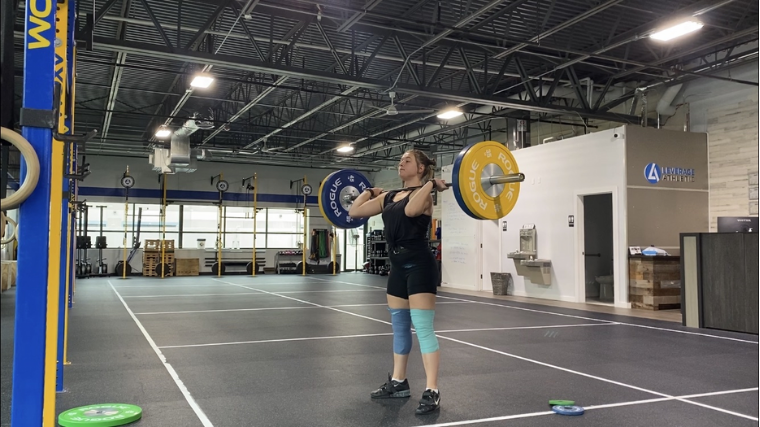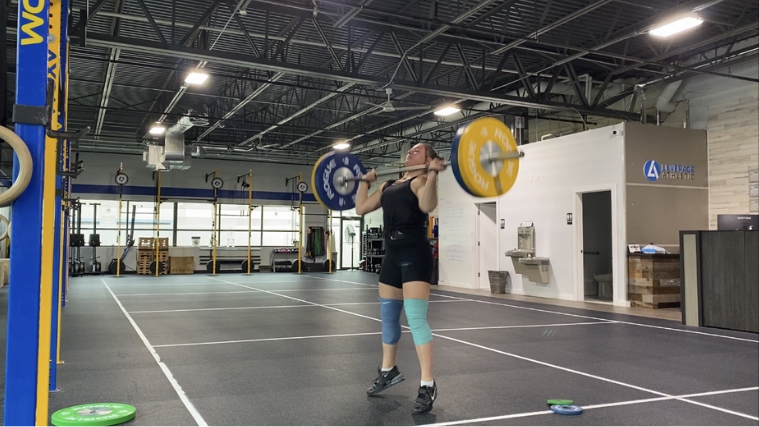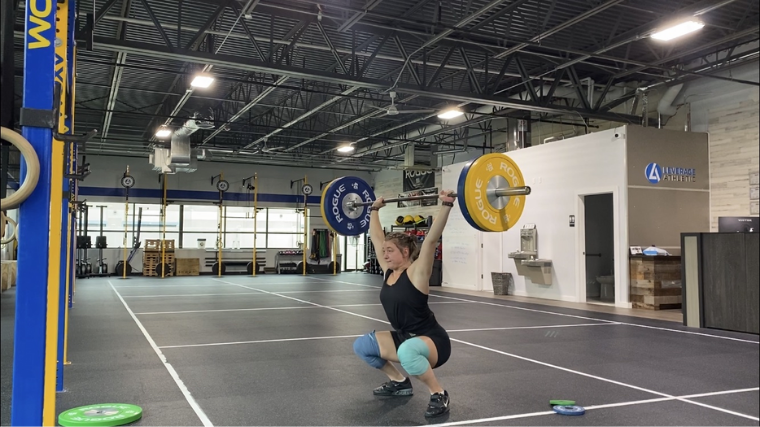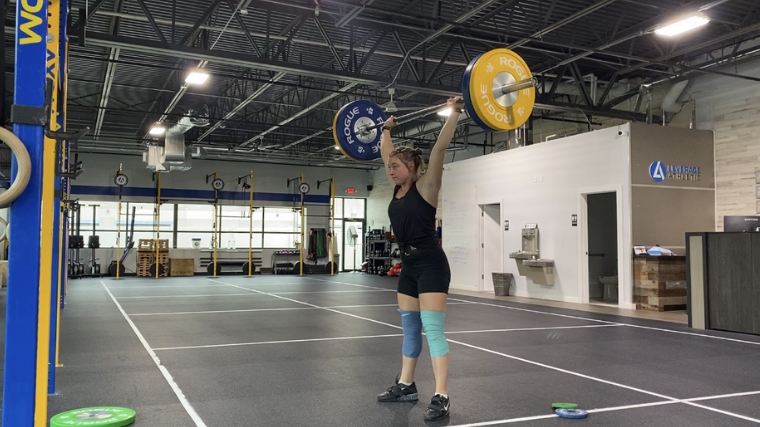There’s more than one good way to get a barbell overhead. In Olympic lifting, you can jerk a barbell to arm’s length with various techniques — the split, push, power, and the infamous squat jerk. The squat jerk’s artful, alluring style might make it seem like it’s only for the cool kids, since it isn’t commonly seen in competition. But if you have the mobility to receive the bar in a deep, stable, and challenging position, the squat jerk might be worth a closer look.
It must be stressed that the squat jerk is debatably the most challenging overhead movement out there, especially from a technical perspective. Performing the squat jerk demands advanced mobility from head to toe. That said, even if you don’t plan on bringing the lift with you to your next meet, there are still some valid reasons to practice the squat jerk in training.
In this article, we will go through everything you need to know about the squat jerk, including:
- How to Do the Squat Jerk
- Benefits of the Squat Jerk
- Muscles Worked by the Squat Jerk
- Who Should Do the Squat Jerk
- Squat Jerk Sets and Reps
- Squat Jerk Variations
- Squat Jerk Alternatives
- Frequently Asked Questions
How to Do the Squat Jerk
The squat jerk is a variation of the jerk in Olympic weightlifting. In the lift, you rapidly push your body underneath the barbell to a narrow-grip overhead squat. The lift is successfully completed when you stand up with the bar locked over your head.
Step 1 — Rack the Barbell

Bring the barbell to your shoulders in a front rack position as you would for a front squat. Your hands should be placed right outside your shoulders. Keep your torso tall and your upper back engaged. Your feet should be hip-width apart, and your legs should be straight.
Coach’s Tip: Your vision should be fixed at eye level, straight ahead. Your center of gravity should be midfoot, centered over the ankle bones.
Step 2 — Dip the Legs

Once set, dip your legs to an athletic quarter squat position. Your hips should travel straight downward a few inches as your knees point out over your toes. Perform the dip with your chest up tall. The dip is essential to get set in the correct position for producing leg power.
Coach’s Tip: In the dip, your elbows should not drop downward at all. This will help maintain your center of balance in the lift.
Step 3 — Drive Up

After hitting the dip position, aggressively extend your hips, knees, and ankles to generate upward drive on the bar. This will force the weight off of your shoulders, allowing you to drop underneath the bar.
Coach’s Tip: Avoid driving the barbell too high — the goal is to drop low into a deep squat.
Step 4 — Catch Low

Catch the barbell in a low squat with your arms extended overhead. In the bottom position, drive your knees outward over your toes. Your hips should sit between your heels to maintain a balanced, upright torso.
Coach’s Tip: To secure balance, you may need to hold this position of the lift for 1-2 brief seconds before standing up.
Step 5 — Stand to Finish

[Read More: The Best Shoulder Exercises for Bigger, Stronger Shoulders]
Once you achieve a stable catch in the overhead squat, stand up with the bar overhead. The lift is considered successful and complete when the weight is held overhead with straight arms and legs.
Coach’s Tip: While standing up with the bar, continue to “reach” your arms overhead to maintain stability.
Benefits of the Squat Jerk
Those who practice this seemingly cumbersome lift will reap the benefits of advanced weightlifting training. Including the squat jerk into your weightlifting program can be a valuable asset to your barbell performance.
Movement Efficiency
The squat jerk is an economical lift compared to other jerk variations, because the barbell does not need to be moved as far in order to secure it overhead. Precision with a heavy, dynamic movement is an essential skill for any lifter. Training the squat jerk over time will ensure that you’re comfortable moving around the barbell.
Overhead Strength and Stability
Holding a barbell overhead — with a narrow grip and in a deep squat position — requires intense upper body strength and stability.
The squat jerk offers a unique stimulus to your shoulders and upper back by forcing you to hold a weight while also sitting in a deep squat. The coordination gained by practicing this lift will undeniably transfer over to your standard jerk technique.
Total Body Coordination
The complex nature of the squat jerk requires total body muscular contribution. Moving both the upper and lower body in such a precise fashion demands a high level of coordination, especially when you start pushing the weights on your barbell.
If you want to become more coordinated and confident with the bar, the squat jerk can be a highly effective means of developing sound movement.
Speed Development
Speed and power define the squat jerk. In order to make the lift, you have to accelerate from a fully extended position to a deep squat in the blink of an eye. The very nature of the lift makes it a fantastic tool for developing raw speed and agility.
Muscles Worked by the Squat Jerk
The musculature of your upper and lower body is put to the test by the squat jerk. Since there are so many moving parts, the lift challenges your body from head to toe.
Quadriceps & Glutes
The lower body is responsible for generating power in the lift. In the dip and drive motion, the quadriceps and glutes vertically force the bar off the shoulders. The lower body then accelerates underneath the barbell to a tight squat position. After a balanced catch, the legs must squat the weight up.
Shoulders
Your shoulders provide the framework for stability throughout the squat jerk. After you’ve driven the weight up, your delts receive the load and must fixate it for the rest of the lift. Your shoulders contract hard to ensure that your arm remains completely still underneath the bar.
Upper Back
Your upper back comes into play in the squat jerk by acting as the base your shoulders stabilize against. You need to have engaged, active scapular stabilizers and lower traps in order for your shoulders and arms to hold the barbell. Without a strong upper back, the squat jerk is doomed to fail.
Core
Your balance in the squat jerk comes down to having a strong core. Your abs work overtime to hold your trunk as vertical as possible and also assist in ensuring a vertical bar path in the drive phase.
Who Should Do the Squat Jerk
Make no mistake — the squat jerk isn’t for everyone. While it is considered a niche within a niche, if applied in the right way as part of a well-made training plan, it can transform your barbell mechanics.
Weightlifters
Due to the high degree of difficulty, the squat jerk isn’t commonly performed in competition. Even weightlifters, who often have good mobility, need lots of practice and patience to execute the lift well.
However, the squat jerk is also the most efficient way to get a barbell overhead, since you don’t need to push it as high. If you have the flexibility, coordination, and body structure to squat comfortably with a close overhead grip, the squat jerk might be up your alley.
[Read More: Powerbuilding Workout Routine, With Tips from a CPT]
For most other lifters, limited practice with the squat jerk should improve their ability to drop under a bar in general, which is relevant in other jerk techniques as well as in the snatch.
Crossfitters
While you’re unlikely to see the squat jerk in a CrossFit WOD, it does bear some similarities to many common functional fitness exercises. CrossFitters with some experience under their belt could make use of light squat jerks as a general warm-up or for developing technique in the overhead squat.
A Note on Body Structure
The squat jerk can be practiced by athletes of any height, weight, or build. However, the extreme positional demands required to execute the lift with serious weights overhead make it potentially ill-suited for certain types of lifters.
Taller athletes with longer femurs and shorter torsos don’t have as much mechanical advantage for overhead squatting as more compact athletes do. If you find yourself struggling with the squat jerk, it may be because you’re not naturally built to excel at the movement.
Squat Jerk Sets and Reps
Depending on why you’re training the squat jerk, there are different methods of use for the exercise.
For Weightlifting Performance
If the squat jerk is used as your main jerk style for weightlifting, it should be practiced regularly as part of your traditional jerk programming. For example, clean & jerk sets and reps throughout the week should be practiced with a squat jerk to ensure that movement efficiency and strength are established.
Incorporate a balance of lighter technique work — 3 – 4 reps at 60 – 75% of your max — and heavier work of 1 – 2 reps at 80% or above.
For Technique Development
If you don’t normally squat jerk, you can still use it as an accessory to develop a straight bar path and better coordination. In this case, keep volume a bit higher for extra practice and limit your intensity.
When using the squat jerk as an accessory for technique, perform 5 – 6 sets of up to six reps with an empty bar to start.
Squat Jerk Variations
The squat jerk movement can be adjusted based on your specific goals of training. These variations can be used in combination with the squat jerk in your program to enhance your jerk technique.
Push Jerk
The push jerk is similar to the squat jerk, but your legs bend only slightly to catch the weight in a high squat. The push jerk allows you to refine your ability to cycle between extension and flexion of the lower body, without requiring excessive mobility from your hips or shoulders.
“No Foot” Squat Jerk
You can dial down the difficulty of the squat jerk by eliminating the foot movement during the transition. Typically, most athletes will lift and replace their feet slightly wider when moving under the barbell.
By keeping your feet glued to the floor, you can still practice the overall technique of the squat jerk while feeling more stable and secure throughout the range of motion.
Squat Jerk Alternatives
The movement pattern of the squat jerk is common to other weightlifting exercises. If the squat jerk is not quite right for you, one of these very similar exercises is likely more suitable for your weightlifting practice.
Split Jerk
The most common style of jerk in weightlifting is the split jerk. The split jerk is an overhead movement in which the barbell is caught in a split stance, which resembles a high lunge. The split jerk offers the most overall stability and is a reliable way to jerk weights overhead.
Overhead Squat
You can improve your flexibility and lower body strength by mimicking the squat jerk via a standard overhead squat. A close grip will challenge your mobility to a higher degree than a wider grip, but any overhead squat will develop synchronized mobility in the hip and shoulder.
[RELATED: Best Mobility Workouts]
Snatch Balance
The snatch balance is similar to the squat jerk. The lift begins with the bar behind the neck rather than in the front rack, held with a wide snatch grip. By driving the bar up, catching it in a partial squat, and “riding” it down, you can work on the overall coordination required for the squat jerk without needing as extreme mobility.
Wrapping Up
The squat jerk is undeniably complex and not appropriate for every athlete. Many lifters are hesitant to include the squat jerk into their training, fearing that the benefits will not outweigh the cost of learning such a difficult technique.
However, the barbell will always present you with new challenges to overcome. By looking at the squat jerk as a potential asset rather than a pitfall to avoid, you might just find yourself more coordinated and more mobile than ever before. All you need is a barbell — or even a broomstick — and you’re ready to explore a new dimension of weightlifting training.
FAQs
When it comes to the squat jerk, things can get complicated quickly. Read below if you need a bit more information before giving the movement a try.
Why is the squat jerk not performed in competition as often as the split jerk?
In weightlifting competitions, the singular goal is to lift the most weight possible. While the squat jerk does theoretically allow for the heaviest bars to be lifted overhead, for many athletes, the precision required and advanced technique make it a risky bet. Most athletes can lift more with a split jerk due to increased comfort and stability, which is all that matters on meet day.
How should I decide which style of jerk to use in competition?
Deciding which style of jerk is right for you requires extensive consideration of your personal ability and strength. It is best to practice each potential variation more than once to determine which jerk style feels most natural for you.